
On today’s Your Call Media Roundtable, we’ll discuss the ongoing crackdown on college campus protests against Israel’s war in Gaza, including at UCLA, Columbia University and University of Texas. We’ll hear from journalists who have been covering these student protests, including:
- Tasbeeh Herwees, a writer, journalist and a member of Writers Against the War on Gaza
- Constanza Montemayor, a senior staff reporter for the the Daily Bruin at UCLA
- Yasmeen Altaji, a multimedia journalist currently pursuing her M.A. in Journalism at the Columbia University Graduate School of Journalism
Then, we’ll talk about the major United Auto Workers’ union victory at a Volkswagen plant in Tennessee, in the heart of the anti-labor union South. Joining us will be:
- Steven Greenhouse, veteran labor journalist and the author of Beaten Down, Worked Up: The Past, Present, and Future of American Labor
- Mike Elk, an Emmy-nominated labor reporter and the co-founder of Payday Report
Tune in at 91.7 FM in the San Francisco Bay Area or stream live at 10am PT. What comments or questions do you have for our guests? Call 866-798-TALK to join the conversation!

I’ll be a guest on KQED Forum at 10am PT today discussing how to improve electric vehicle charging infrastructure in California.
Electrical vehicle purchases in the state dropped significantly in the second half of last year, for the first time in a decade. It’s likely this is just a blip, but some potential EV buyers say that they’re holding off because of concerns over public charger access and reliability.
The situation may be improving though: California approved a $1.9 billion dollar investment in EV charging infrastructure last month, which will bring 40,000 new chargers online – including in rural areas.
On the show, I’ll talk about what California needs to do to meaningfully expand its EV charging infrastructure ahead of its 2035 ban on the sale of new gas-powered cars. Joining me on the panel will be:
- Russ Mitchell, Automotive Editor, Los Angeles Times, who covers the automotive industry.
- Terry Travis, managing partner, EVNoire, a Mobility Consulting Group that works to integrate and amplify diversity, equity, and inclusion in the electric transportation sector.
Tune in on KQED 88.5 FM in the San Francisco Bay Area or stream live at 10am PT!
California’s ambitious goal to end the sale of internal combustion engine passenger vehicles by 2035 will require addressing the challenges faced by lower- and moderate-income drivers in accessing battery-powered electric vehicles (EVs). Chief among these concerns is their need to have a convenient and affordable place to charge the vehicles.
Currently these residents too often experience limited access to EV charging stations, especially in lower-income communities characterized by lower home ownership rates and higher rates of tenancy in apartment buildings. Residents in these areas are more likely to lack dedicated parking spaces equipped with electric outlets, hindering their ability to charge EVs conveniently. Even those with garages or parking spaces may face financial constraints when it comes to investing in private charging and electrical upgrades. Compounding these challenges is the often-inadequate grid infrastructure in lower-income areas.
In response to these obstacles, UC Berkeley School of Law’s Center for Law, Energy & the Environment (CLEE) partnered with the City of Watsonville, a diverse city of 50,000 in Santa Cruz County’s agricultural heartland. Due to its location, demographics, and ambitious policy goals, Watsonville represents a potential model and case study for other cities around the state grappling with how to boost zero-emission vehicle charging infrastructure.
Today CLEE is pleased to release a new report, which draws on stakeholder interviews and a convening held in Watsonville to offer a set of policy recommendations for both state and local leaders. These recommendations aim to accelerate investment in EV charging infrastructure not only in Watsonville but other cities facing similar challenges in meeting state targets while addressing lower-income residents’ needs.
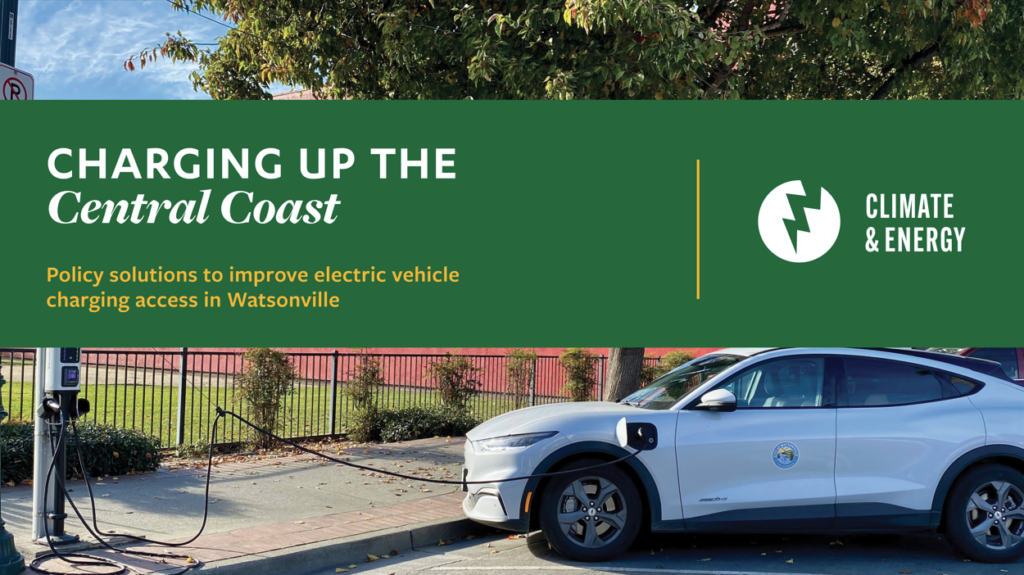
- Comprehensive Mapping Assessment: Watsonville’s City Planning Department and Public Works & Utilities Department could initiate a comprehensive mapping assessment to determine optimal and equitable charger locations based on local needs and transportation patterns.
- Zoning and Permitting Policies: Watsonville’s City Planning Department could revise zoning and permitting policies to require EV charger installation or EV-ready electrical infrastructure at certain priority locations.
- Electricity Rate Optimization: The CPUC and utility companies could implement electricity rates that reduce the cost of charging during off-peak hours and improve transparency for consumers about these rates.
- Community Awareness Campaigns: The state transportation agencies could expand support for community based organizations in Watsonville that conduct targeted, multi-lingual public awareness campaigns about the potential cost savings and benefits from switching to EVs.
By prioritizing charging access, state and local leaders can ensure that California’s path toward equitable EV deployment is not only aspirational but also achievable, particularly for the lowest-income drivers in the state. The lessons learned from Watsonville can serve as an example for other cities grappling with similar challenges, ultimately contributing to a more inclusive and sustainable transportation landscape.
Read our full report here- Charging up the Central Coast: Policy solutions to improve electric vehicle charging access in Watsonville
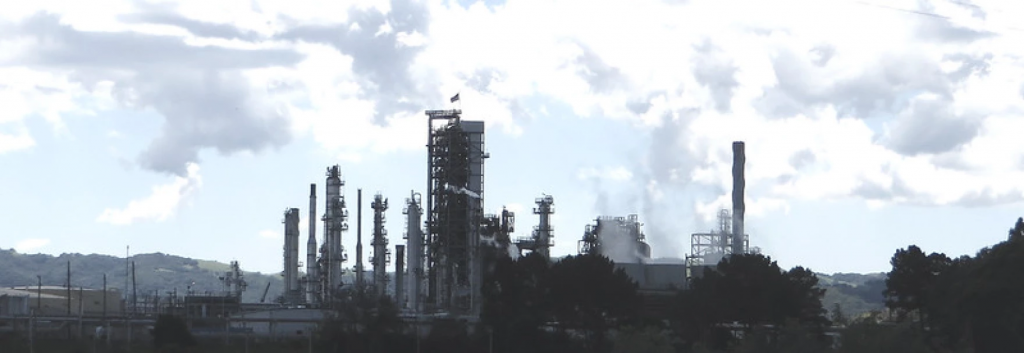
On tonight’s State of the Bay, we’ll discuss California’s role at the just-concluded United Nations Climate Conference (COP 28) and dig into what the agreement to begin reducing global consumption of fossil fuels might mean for Bay Area refineries. Plus, we’ll take a tour through the WPA murals of Coit Tower.
First, we’ll talk with Assemblymember Rebecca Bauer-Kahan, representing California’s 16th Assembly District in the East Bay, about the role of California and the Bay Area in this year’s COP.
Then, we’ll look at how the agreement reached at COP 28 to begin reducing global consumption of fossil fuels might mean for Bay Area refineries. Joining us will be:
- Ann Alexander, senior attorney with the Natural Resources Defense Council
- Greg Karras, independent consultant, senior scientist for Communities for a Better Environment and author of “Decommissioning California Refineries: Climate and Health Paths in an Oil State.”
Finally, we’ll take a tour through the WPA murals at San Francisco’s Coit Tower with Charlie Goldman.
Tune in at 91.7 FM in the San Francisco Bay Area or stream live at 6pm PT. What comments or questions do you have for our guests? Call 866-798-TALK to join the conversation!

In the race to scale up a global supply chain for electric vehicle batteries, mining justice advocates have sought to ensure that the ongoing clean technology minerals boom does not exacerbate longstanding negative impacts from the global mining industry. Chief among these are corruption risks.
To provide guidance to electric vehicle purchasers (particularly fleets), advocates, and leaders in “downstream” markets about how to support anti-corruption measures in the battery supply chain, Berkeley Law’s Center for Law, Energy and the Environment (CLEE) partnered with the Natural Resource Governance Institute to issue a new policy brief: Corruption Risks in the EV Battery Supply Chain: What Advocates, Automakers and Fleet Purchasers Can Do.
The brief presents a set of actions for “downstream” markets, such as in the United State and European Union. Among the steps that the report recommends these actors take:
- Battery manufacturers, automakers, and fleet purchasers could integrate checks on corruption risks into responsible sourcing and due diligence systems. Risks from supply chain relationships may directly affect company operations, and companies can leverage their influence to promote better practices and policies. When necessary, they should be willing to disengage or suspend engagement with suppliers.
- Manufacturers, automakers and purchasers could also encourage project-level contract, payment, commodity trading, and beneficial ownership transparency and robust ethics and compliance policies from suppliers. Companies could look for comprehensive project or sale-level disclosure of contracts and licenses, payments to governments, and verified beneficial ownership information, internal oversight and independence of ethics and compliance procedures, robust disciplinary and remediation procedures.
- Electrification and sustainable mining advocates in North America and Europe could emphasize the importance of governance and anti-corruption measures in their advocacy. Specifically, advocates can better incorporate anticorruption into benchmarks or reports that assess companies’ sustainability provisions and/or responsible sourcing.
- Advocates could push for governments to incorporate strong anticorruption provisions into sustainability criteria for mining projects, in policies and legislation addressing responsible sourcing or due diligence, and in partnerships or trade deals with mineral-producing countries.
Ultimately, corruption is not a victimless crime. It undermines trust in government and deprives the public of needed revenues from mining projects. It can also jeopardize supply chain affordability and reliability as the world makes this critical transition to a cleaner transportation system. With the steps outlined in Corruption Risks in the EV Battery Supply Chain: What Advocates, Automakers and Fleet Purchasers Can Do, advocates, purchasers and downstream market leaders have an opportunity to ensure that the electric vehicle mining boom doesn’t replicate past and ongoing harms from the global mining sector.

The Ports of Los Angeles and Long Beach are major polluters in the region but also potential models for climate action — if they can electrify their equipment, from fork lifts to cranes. A new report released by UCLA Law’s Emmett Institute on Climate Change and the Environment and UC Berkeley Law’s Center for Law, Energy & the Environment (CLEE) —A Heavy Lift: Policy Solutions to Accelerate Deployment of Zero-Emission Cargo Handling Equipment at the Ports of Long Beach and Los Angeles and Beyond—surveys the biggest obstacles to speedy electrification and makes some recommendations.
Greenhouse gas emissions at the Ports come from three main sources: ships, heavy-duty vehicles, and cargo handling equipment (“CHE”). Cargo handling equipment is the third largest source of emissions accounting for approximately 14 percent of the Ports’ total greenhouse gas emissions. The Ports have replaced some fossil-fuel powered equipment with zero-emission models as they work toward goals set forth in their Clean Air Action Plan, including a goal to transition to 100 percent zero-emission CHE by 2030. However, more work is needed to fully transition the Ports large CHE fleet to zero-emission models. While some consider cargo handling equipment the “low hanging fruit” of port emissions reductions, there remain challenges for the transition to zero emissions. Some of the needed ZE technology is still being developed, and communities and workers have raised concerns around the potential for job loss.
To address these concerns, the law schools hosted a convening of experts from a variety of industries, including environmental, public health, environmental justice, labor, business, and government sectors. We discussed the challenges and opportunities of decarbonizing cargo handling equipment at the Ports. The report discusses the top barriers to transitioning to electric CHE models and proposes solutions to overcome these barriers.
The report dives into the following barriers:
- Inadequate grid and charging infrastructure to support zero-emission cargo handling equipment and lack of substantial planning and funding to install necessary and timely infrastructure.
- Evolving zero-emission technology for some types of cargo handling equipment and high upfront costs.
- Fear among communities and workers of job loss and of increased emissions from expanded port activities.
The report then recommends several solutions, including:
- The Ports and utilities, chiefly Southern California Edison and Los Angeles Department of Water and Power, could proactively deploy “no regret” infrastructure, including increasing grid capacity and upgrading distribution networks that will be needed regardless of how zero-emission cargo handling equipment is powered.
- The California Legislature; the Air Resources Board; and/or the South Coast Air Quality Management District, using their existing authority grounded in air pollution control, could create technology-forcing mandates and clear, enforceable implementation deadlines, with penalties for non-compliance, to catalyze the zero-emission cargo handling equipment transition. Where technology is not readily commercially available, regulations could incorporate adequate flexibility and sufficient lead time for entities to meet the mandate.
- State and local government could implement policies to promote job preservation, local job creation, and worker training, such as programs that encourage ports and terminal operators to partner with local training organizations to upskill and reskill the workforce to use the new vehicles and technologies.
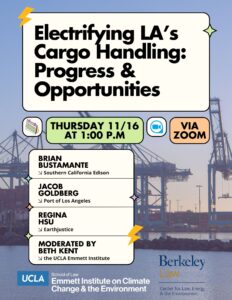
Given the importance of the Ports to worldwide commerce, they could help inform climate action at ports around the globe, if they and policy makers can collaborate to achieve these zero-emission goals.
If you want to dive into this topic further, join us for a webinar discussion today, Thursday, November 16th at 1pm PT when we’ll discuss solutions with panelists from Southern California Edison, the Port of Los Angeles, and Earthjustice (RSVP here).
This report is ultimately part of a series on business solutions to address climate change. Read more: A Heavy Lift: Policy Solutions to Accelerate Deployment of Zero-Emission Cargo Handling Equipment at the Ports of Long Beach and Los Angeles and Beyond.
This post was co-authored by Beth Kent and Gabi Rosenfeld.

On tonight’s State of the Bay, I’ll be speaking with Ricardo Cano, transportation reporter for the San Francisco Chronicle, about why state regulators have revoked permits for Cruise’s driverless autonomous vehicles. What are the implications for the autonomous vehicle industry here in California and beyond?
We’ll also hear from Los Angeles Times environmental reporter and author Rosanne Xia about her new book “California Against the Sea: Visions for Our Vanishing Coastline.”
And finally, we’ll sit down with Emily Pilloton-Lam, founder and executive director of the Berkeley non-profit Girls Garage.
Tune in at 91.7 FM in the San Francisco Bay Area or stream live at 6pm PT. What comments or questions do you have for our guests? Call 866-798-TALK to join the conversation!
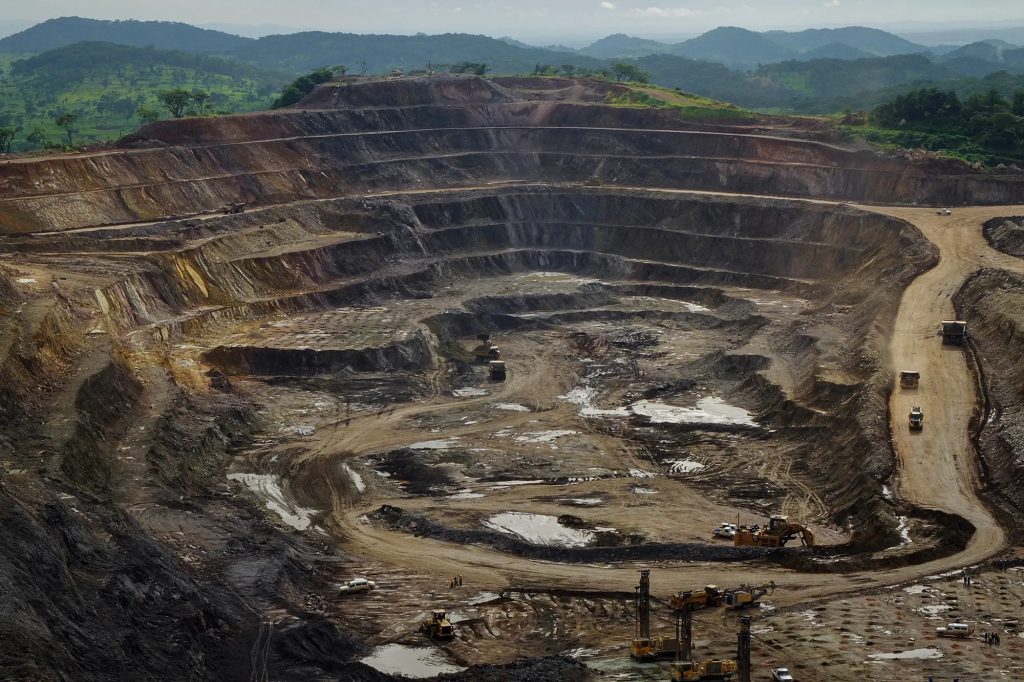
We need electric vehicles to fight climate change, and that means a lot of mining for minerals like lithium and graphite for the batteries. It’s better if that mining happens in the US rather than overseas, where worker and environmental protections may be weaker. But we still need to improve mining processes here.
My new op-ed in The Hill has recommendations on how to do so, following the release of a new federal interagency report on mining. The report calls for permitting agencies to conduct better upfront planning to ensure new mining activity is not sited in sensitive areas that would likely produce conflict, litigation and delay. To do this, I argue:
Specifically, the country can take its cue from California, where a public-private partnership among state government, academic institutions and nonprofits pioneered a stakeholder-led process to map lands for large-scale solar development in key regions in the state. That process resulted in the identification of hundreds of thousands of “least conflict” acres, which participants as diverse as Tribes, ranchers, endangered species advocates and developers agreed would be feasible to develop without harming communities or important resources. This approach is now being replicated in other states.
If we can pull this process off in this country, the result would be fewer conflicts, a more sustainable supply chain for EV batteries, and economic and environmental wins for the communities surrounding mines, including many tribal and rural communities. And maybe it could provide a model for other jurisdictions to follow suit, as the world undergoes a dramatic and badly needed transformation in its vehicle fleet to EVs.
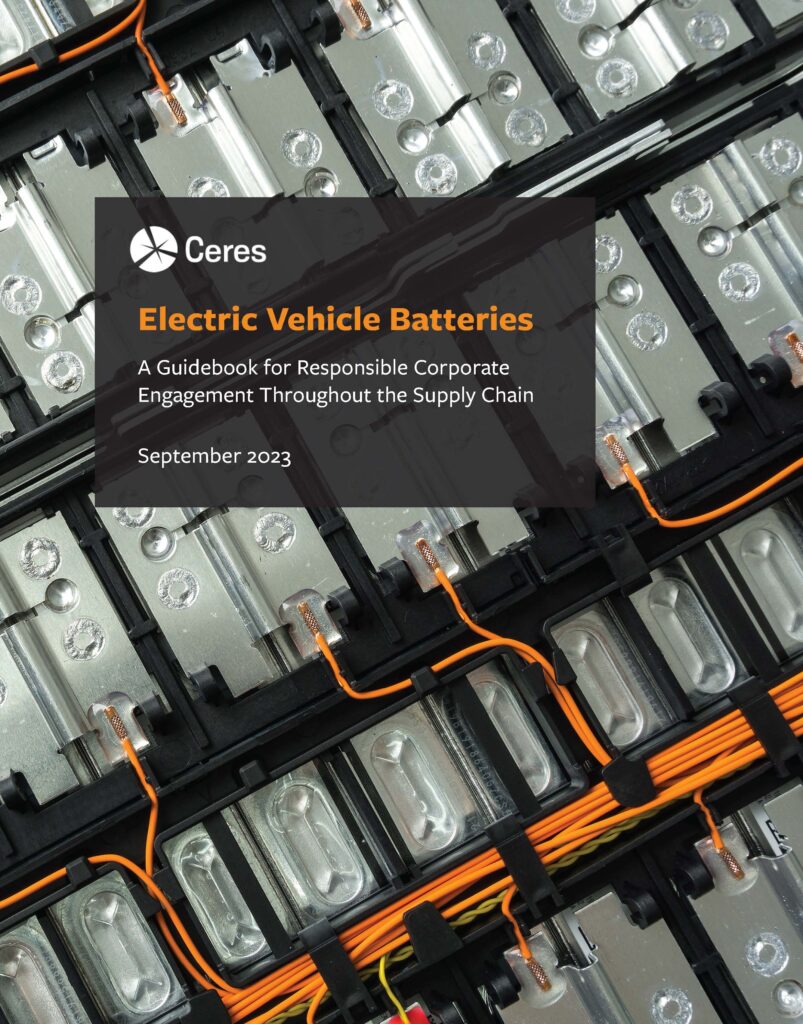
The electric vehicle (EV) market is growing rapidly, but with this growth comes public pressure to ensure supply chains for EV batteries are sustainable. The soaring demand for batteries relies heavily on the extraction and refinement of critical minerals, processes that have far-reaching environmental and social impacts. Moreover, the global distribution of these operations leaves them susceptible to geopolitical instability, further complicating the supply chain.
At the same time, this growth in mining and manufacturing also presents an opportunity to avoid recreating the harms of past mining and industrial activities. While individual EV buyers have little leverage over the industry, fleet purchasers of EVs instead have an opportunity to use their combined market power to ensure upstream suppliers adhere to strong sustainability standards. Corporate fleets can wield their collective influence and purchasing power to drive change on a large scale.
With that market power in mind, our climate program at Berkeley Law’s Center for Law, Energy and the Environment (CLEE) has partnered with the nonprofit Ceres and its Corporate Electric Vehicle Alliance (CEVA), a collaborative group of companies focused on accelerating the transition to EVs, to release a new report with recommendations for major corporate EV fleet purchasers for how they can help ensure supply chain sustainability.
Among other solutions, the report recommends that corporate actors looking to make EV fleet purchases:
- Join the Initiative for Responsible Mining Assurance (IRMA) in order to publicly demonstrate commitment to responsible sourcing; and add political momentum and end-user economic clout to IRMA’s efforts to engage and audit the mining industry
- Advocate for domestic mining reform that expands mining only as much as necessary while ensuring responsible environmental management and clean up as well as community and Tribal engagement
- Participate in extended producer responsibility schemes and build partnerships with second life and recycling entities.
- Advocate for federal policy to standardize EV battery labeling and traceability through an open-source, interoperable digital product passport with requirements designed to improve environmental and human impacts, carbon footprint, and end of life opportunities.
- Advocate for federal policy to standardize EV battery labeling and traceability through an open-source, interoperable digital product passport with requirements designed to improve environmental and human impacts, carbon footprint, and end of life opportunities.
While the report’s primary focus is on U.S. companies operating electric vehicle fleets, the information and recommendations can also benefit other companies involved in the EV supply chain. The goal is to highlight areas where corporate advocacy and procurement practices can have the most impact in promoting a sustainable EV industry.
Ensuring a sustainable EV battery supply chain—one that maximizes benefits for communities, industry, and the environment—will require long-term, coordinated action by stakeholders across the globe. Large fleets and major companies can leverage their purchasing power and engagement with industry to incentivize manufacturers and mining operators to prioritize sustainability and responsible practices. The recommendations in this guidebook offer a roadmap for corporate procurement practices, supplier engagement, and support for policies and initiatives that aim to make ethical sourcing and environmental stewardship the industry norm.
Access the full report here: Electric Vehicle Batteries: A Guidebook for Responsible Corporate Engagement Throughout the Supply Chain
This post is co-authored with Shruti Sarode and cross-posted on Legal Planet.
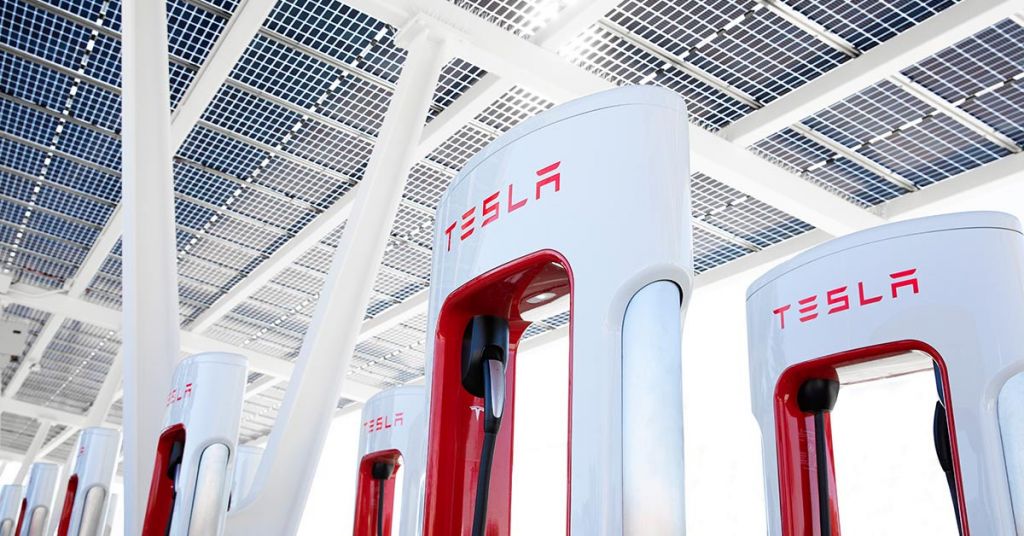
Like the proverbial Betamax vs. VHS technology competition of the 1980s, EV fast charging has been caught up in a wasteful turf war involving three different formats, basically boiling down to Japan versus Europe/North America vs. Tesla. But now we suddenly have a winner, as first Ford and then General Motors and startup Rivian have all pledged in the past few weeks to adopt the Tesla charging standard in their vehicles starting next year, with adapters available for consumers this year.
It couldn’t happen soon enough. The differing charging formats means EV drivers are limited where they can get fast charging or have to carry adapters, while non-Tesla charging stations had to have multiple plugs available for different formats.
The other problem is that non-Tesla chargers are basically awful. They’re unreliable, clunky and often with low power. While legacy automakers dithered and refused to invest in a network of chargers, Tesla instead built a user-friendly, ubiquitous network. The company is now poised to reap the economic benefits, from its position as a dominant market leader in vehicle sales.
One of the big questions now is what happens to all the soon-to-be-obsolete chargers out there? Companies like EVgo and Electrify America have built thousands of fast-charger stations with formats that are now zombie technology. Worse, the public has invested significantly in these stations, with EVgo a creation of a $100 million legal settlement from the California energy crisis circa 2000, while Electrify America was funded with dollars from the Volkswagen “dieselgate” emissions cheating settlement, to the tune of almost $1 billion in California alone.
All will not be lost, as the stations can be retrofitted in some cases. The wiring is sometimes the hard part, so charger replacement by itself may not be too expensive. But in some cases, retrofits may be uneconomical. And ultimately, these companies are likely to go out of business, unless they can get access to Tesla’s intellectual property to build their own versions of a Tesla SuperCharger.
If not, Tesla will have a monopoly on charging stations, which will create its own long-term problems. But for now, the charging format wars have ended, in favor of a far superior product.
That’s something that both EV advocates and drivers can finally celebrate.


